“She went up the rope about three yards, and then came down. She did not fall, but came down the rope.”
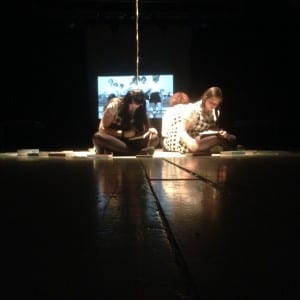
Framing Statement
‘The Third Beam’ was a piece of site-specific performance created as part of the Lincoln Drill Hall Project. It was performed on the 4th May 2016 in the main auditorium of the Drill Hall and consisted of both an installation and nine one to one performances. We began creating the installation at 12pm and began the one to one performances at 2pm. We finished the entire performance at 4:45pm.
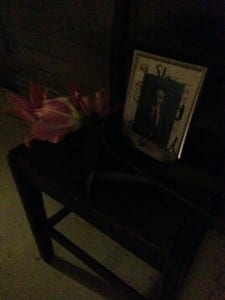
From 12pm, we sat in silence creating the installation with torn pages from 17 books (the age Rosamund was when she passed away) that audience members were free to come and watch as and when they pleased. Audience members were guided through the main auditorium for other performances by other members of the project, so they were welcome to come and watch this pre performance. After 2pm, audiences were asked to sign up in the café, where they were then collected for the one to one shows. Before they were taken into the auditorium, we performed a small piece to the audience members in the café as it gave a good juxtaposition of the loud and vibrant atmosphere, to the silence and eeriness of the auditorium that we had created. We asked the audience to look at all the memorial pieces in the Drill Hall, in particular the large plaque dedicated to the soldiers. We then led them through the doors into the auditorium and asked them to close their eyes whilst we led them into the spotlight and laid them down. As we read them the script, describing the day Rosamund died, the other two performers were continuing to make the installation. We then helped them up and asked them to open their eyes where they watched a video of the pre performance walk we had recorded on April 10th 2016 (the 117th anniversary of Rosamund’s funeral) from Lincoln Christ Hospital Girls School to the Drill Hall. They were then taken to a table with a framed picture of Rosamund and 3 lilies to represent the three performers. It was explained that we were going to leave the frame in the Drill Hall as a memorial as there currently weren’t any dedicated to her and the lilies were going to be left outside her school gates as part of our post performance. Audience members were then free to leave or continue to watch us set up the rest of the installation or watch the video that was on a constant loop.
“To the Glory of God and in loving memory of Rosamund, only daughter of HS Acworth, vicar of Chobham, Surrey. She died in Lincoln Gymnasium April 6th 1899 aged 17.”
During one of our lessons, we watched several extracts of site specific performances from The Many Headed Monster in which we learnt about the ideas of pre performance, performance and post-performance. We began to question what makes a performance and when it ends for an audience. We wanted to experiment with this idea and so decided to split our performance into 3 sections. As we chose to base our piece on the idea of memorials, in each section we made a new memorial to Rosamund.
For our pre performance, we were intrigued by the work of William Pope.L who “famously crawled along 22 miles of sidewalk” (Simonini, 2013). Whilst he did this to highlight and “address societal concerns” we were fascinated by the idea of going on a journey and so decided to make the last journey Rosamund ever made as a memorial to her memory. We filmed the walk on 10th April, 2016 which was the 117th anniversary of Rosamund’s funeral. In allowing our audience to see this it would immerse them in the events that led up to Rosamund’s death and allow them to grow a greater personal connection to her.
https://www.youtube.com/watch?v=9P5i2rGZqI8
Avery,M. (2016) The Third Beam Pre Performance [online video] [Accessed 12th May 2016]
Our post performance worked on this same principle, however, the audience did not witness first-hand the walk we made back to her school, they were simply told about this pilgrimage during the one to one performances. However we documented this journey by videoing at the same points we had in the pre performance.
https://www.youtube.com/watch?v=b7p3yRC6vcQ
Avery,M. (2016) The Third Beam Post Performance [online video] [Accessed 12th May 2016]
Analysis of our Process
In our first session at the Drill Hall, we were introduced to the concept of ‘drifting’. Drifting is used to discover areas of a building or space which you may not have noticed had you been walking with a specific destination in mind. Practicing drifting around the Drill Hall allowed our group to see things we would have previously ignored, such as strange architecture, hidden signs or unused spaces. The use of drifting influenced our final performance in many ways. Working from Phil Smith’s ‘Handbook of Drifting’ in Mythogeography, we looked at the many ways in which people make drifting successful. One section we found interesting was step 14: “Avoid art, mostly. Enjoy rotting, splintered, stained, overgrown or torched public art” (Smith, 2010, 120). We found this step the most helpful to our final performance as it gave us the inspiration to look for the lost and forgotten history of the Drill Hall and the darker stories that tend to be disremembered. The drifting also led us to find an area that we immediately fell in love with. Our search for areas that were forgotten or unused led us to find an area underneath the seating. The dark and dreary atmosphere really fit in with the type of story we were hoping to portray. It was at this point we were told by the Drill Hall the story of Rosamund Acworth and her untimely death during a gym class. I felt a connection to this story and upon researching, we found many people were unaware of her existence and it was therefore the hidden story we were looking for and wanted to bring attention to.
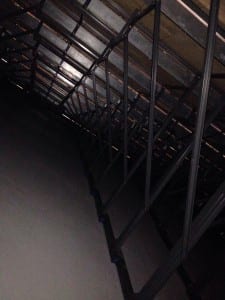

In addition to drifting, we were encouraged in class to look at the work of Willi Dorner and his bodies in urban places. Dorner describes the reasoning behind this performance as inviting “residents to walk their own city thus establishing a stronger relationship to their neighbourhood” (Dorner). As we had already found a performance area we wanted to use that linked with our idea of a hidden history, we used drifting as it allowed us to become more connected to the space and further understand the energy.
Back to the drawing board
Now without a space to use, we carried out more research into Rosamund and came across a newspaper article that had been published two days after she died. From this we learnt the rope she had been climbing in her gymnastics lesson had been hanging from the third beam, which led us to deciding to perform in the main auditorium and creating a performance in the spot in which she died. We felt this connection strong historical connection to the Drill Hall could have just as much of an impact, if not more, on an audience member as they then don’t just become spectators, they would become immersed in the final moments of her life on a level that wouldn’t have been achieved had it been performed in another space.
Our Inspiration
Throughout the process, we were asked to look at and create presentations on different site specific theatre companies that may influence our piece. One company we particularly enjoyed looking at was Talking Birds Theatre Company. A specific performance we had a look at was A City Grown from Words which created an installation of letters written by members of the public in a sorting office that closed down in 2011. This gave us the idea to create an installation as we found the visual effect enhanced the performance when the audience could return and see the progression from start to finish.
Talking Birds also created a performance named Wanderlust in which they used projection to recreate what the area would have looked like before the new buildings were put in place. Their idea of using projection and technology to portray what had happened before led us to the decision of showing the walk throughout the entire 4 hours and 45 minutes of performance to show the audience what had happened both before our performance and before Rosamund’s death.
Towards the end of the project, we began to come across problems with our performance element. In order to find inspiration, we were encouraged to look at The Long and Winding Road by Michael Pinchbeck. The way the script was delivered to tell a story gave the sense of intimacy we were hoping to achieve in our performance. We therefore decided to simply tell the audience Rosamund’s story in the same style and calming tone of voice rather than becoming characters from the gym class as the audience member then couldn’t disassociate themselves from the story.
The Final Rehearsals
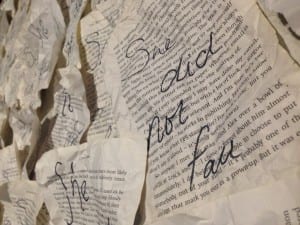
As we got closer to the day of our performance, we had a few problems with getting into our space as there were other performances taking place. So we decided to try and find places where we could recreate what we were planning to do to the best of our ability. We tested how we were going to create our installation. When we practiced tearing up 17 books and writing on them, we realised that even in a smaller space, we weren’t going to be able to fill the entire auditorium which is what we had originally planned to do. We therefore decided to build up the pages from the outside of the spotlight as far as we could so it gave the same effect to the audience.
In our rehearsals we had used sound. However, on the day, our audio track of a heartbeat couldn’t be used due to technological difficulties. Nevertheless, upon reflection, we preferred the silence because it made the atmosphere of the piece scarily unnerving and we imagined there would have been silence the moment in which Rosamund came down the rope.
Performance Evaluation
Overall, I believe our performance went very well on the day. Despite the exhaustion that followed the end of the show and being covered in charcoal, I was very proud of the installation we had managed to create. All the pages in the 17 books had been ripped out and written on so we managed to achieve the goal we set out to achieve in the allotted time. The intimate nature of holding hands and speaking directly to one person in the performance didn’t give room for many audience members and we only had 9 one to one shows that lasted 10 minutes each. We listened to comments from one member of the audience afterwards and they mentioned that they thought the show was “thought provoking and meaningful”.
I believe the best part of our performance was the intimacy and physical contact between the performer and audience member. On the line “they laid her out, loosened her clothing, bathed her head…” (Avery et al, 2016), we put our hand on the audience members head and took their pulse when we announced the time of death for Rosamund. Performing Site-Specific Theatre says that intimacy in theatre is “designed to intensify the theatre experience” (Birch and Tompkins, 2012)and so by doing this, we allowed the audience to become connected to the story and the space in the same way we had done throughout the process on an emotional level.
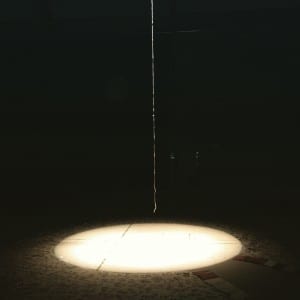
After the performance, I feel that there are things I would have changed. Whilst we explained what happened to Rosamund during the one on one performances, people who were watching us set up the installation in the first two hours may not have understood the video, the significance of the spotlight or the books. Therefore, in hindsight, we probably should have put up a sign explaining the story of what happened to her so every audience member would have had a full appreciation of the performance, whether it was one to one or simply a spectator. This would have helped us to better achieve our performance goal of immersing the audience into the final moments of Rosamund’s life.
In addition to this, I think we would have changed the way in which we interacted with the audience during the process of getting the audience member to laying down in the spotlight with their eyes closed. We hadn’t taken into account that an audience member may have bags and possessions with them and so when talking to them we became hesitant and not as assured in what we were saying as when we were on script. This therefore compromised parts of the performance as we broke out of our ‘character’. Similarly, I feel we should have worked out a better way of ending the performance, as I didn’t account for an audience member staying within the auditorium when we were due to finish and we couldn’t pack away until they had left.
From the final performance itself, I’ve learnt about the strong emotional connection a site can hold. It wasn’t until we got into the final performance that I was able to truly appreciate the scale of this connection to the history we had learned about throughout the course and not just the story we were basing our own performance on. I think this connection allowed us to create a new and eerie atmosphere in the Drill Hall auditorium that resonated with our audiences and they walked away knowing about a moment in history that the Drill Hall seemed to have all but forgotten. Mike Pearson states in his book Site Specific Performance that “the conventions and techniques of the auditorium may be inappropriate or inadequate to the task of addressing ‘site’” (Pearson, 2010, 1). Looking back on the performance, I’ve realised the challenges that come with devising a site specific performance. However, the possibilities go way beyond that of traditional theatre and performing on a stage with an audience sat watching and the space can be transformed into whatever you envision. Also that an audience can become a lot more connected to a performance than they would do if they were simply sat down watching people on a stage.
Word Count: 2416
Works Cited
Avery, M., Brammah, F. and Wood, E. (2016) The Third Beam. [performance] Lincoln: Lincoln Drill Hall, 4th May.
Birch, A and Tompkins, J.E. (eds.) (2012) Performing site-specific theatre: Politics, place, practice. Basingstoke: Palgrave Macmillan.
Dorner, W. Bodies in urban spaces. [online] Available from http://www.ciewdorner.at/index.php?page=work&wid=26 [Accessed 5th May 2016].
Pearson, M. (2010) Site-Specific Performance. Basingstoke: Palgrave Macmillan.
Simonini, R. (2013) William Pope.L. [online] Available from http://www.interviewmagazine.com/art/william-popel#_ [Accessed 5th May 2016].
Smith, P. (2010) Mythogeography: a guide to walking sideways. United Kingdom: Triarchy Press.
Talking Birds. Site-specific and site-responsive works. [online] Available from http://talkingbirds.co.uk/pages/sitespecific.asp [Accessed 5th May 2016].